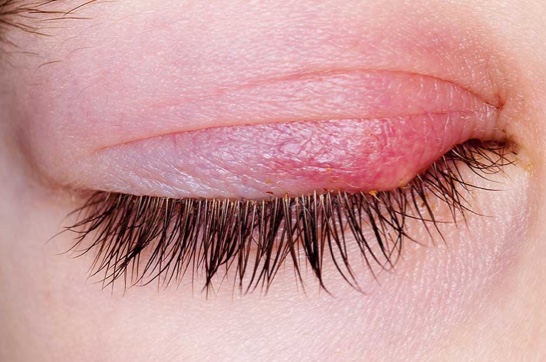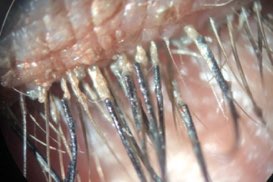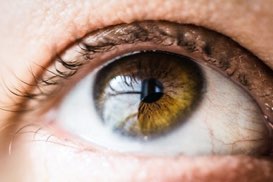By Sumathi Reddy
From The Wall Street Journal
A growing number of people are landing in their doctor's office complaining of gritty, irritated and burning eyes.
No, it isn't allergies or an eye infection. Most of these patients are suffering from dry eye, a condition that affects as many as 25 million Americans, according to eye-care industry estimates. Eye doctors say dry-eye syndrome is especially prevalent among women and older people and is the second most common complaint after vision problems.
"It's an epidemic now," said Stephanie Marioneaux, an ophthalmologist in Chesapeake, Va. "At one point primarily it was postmenopausal women. Now I have all kinds of dry-eye patients."
Behind the growing number of cases: Mucus membranes that produce a key component of tears naturally dry up as people age. Spending a lot of time in low-humidity environments, such as air-conditioned office buildings or airplane cabins, also can promote dry eye, as a recent study published in the journal Cornea found. And staring at a computer or smartphone screen for long periods also can contribute to dry eye, as people forget to blink.
"I have patients who have jobs that require them to stare at a computer all day," said Dr. Marioneaux. "I have them put a sticker on their computer that says, 'Blink!' " Ideally, a person should blink 12 to 15 times a minute, she said. Other reasons behind dry eye can include certain autoimmune diseases, and medications like antihistamines and antidepressants. Some eye surgeries, such as Lasik, can cause temporary dryness. Dry and windy climates can contribute to dry eye, as can contact lens intolerance and eye makeup.
There are two main types of dry eye. One occurs when your eyes aren't producing enough tears. For a long time, doctors believed this was the main culprit. But in recent years there has been recognition that poor tear quality, often referred to as evaporative dry eye, is far more prevalent, accounting for the majority cases. Many people have both problems.
Coating the surface of the eye is a protective tear film that consists of three main components-an outer, oily layer that prevents evaporation and a watery layer mixed with bits of a gel-like substance called mucin that holds the tear film to the eye. Evaporative dry eye occurs when the so-called meibomian glands, located in the upper and lower eye lids, don't produce enough oil, or the oil isn't of high quality. This causes the watery layer of the tears to evaporate more quickly.
Every time you blink and your top lid touches the bottom lid, the meibomian glands squirt oil that stabilizes the tear film, said Dr. Marioneaux. "If you're not blinking completely, which actually a lot of people do, you're not getting the release of this oil. So oil backs up in the lid and begins to get thicker and starts to clog up the oil gland," she said.
Most dry-eye patients have relatively mild symptoms, which can include a gritty feeling, burning or itching and sometimes blurry vision. Excessive tearing can occur when the body responds to the dryness by producing more tears as a protective mechanism. More severe cases can result in a stabbing pain caused by exposed nerves on the dried surface of the eye that become irritated from the formation of microscopic erosions.
Brad Feldman, a cornea, cataract and refractive surgeon at Wills Eye Institute in Philadelphia, said contact-lens wearers with dry eye can be more prone to infection and irritation, such as getting a scratch on the eye.
Finding the right treatment to reduce dry-eye symptoms can involve trying different products and approaches. Most people start with over-the-counter drops to replenish moisture and tears. Some of the newer products also try to address evaporative dry eye by replenishing the tear film's oil layer. For patients who use drops more than three or four times a day, doctors recommend getting products without preservatives, which can cause some discomfort. Preservatives are sometimes added to drops to prolong their shelf life while keeping bacteria at bay.
Gel drops and ointment can help in cases of severe dry eye. These treatments may cause blurred vision so are usually recommended for nighttime use. They are also recommended if patients have a condition in which the eye doesn't fully close at night when sleeping.
Some patients also benefit from the use of an anti-inflammatory such as steroids or omega-3 fatty acids to reduce inflammation of the glands, or antibiotics, taken orally or topically. Allergan's Restasis, an anti-inflammatory eye drop, is the main prescription drug used, primarily for individuals who don't produce enough tears. Dr. Feldman said antibiotics also appear to alter the eye's oil production although it isn't clear exactly how. He said he is currently involved in a study testing the application of an antibiotic to the eyelid margin to see if it can improve the quality of the oil in the tear film.
Another procedure to treat dry eye is called punctal plugs. The puncta, the hole in the corner of the eyelid where tears drain to the back of the nose and down the throat, is plugged so tears stay in the eye longer. The hole can also be permanently closed with heat in a more invasive procedure.
For evaporative dry eye, experts recommend warm compresses or eye massage to unclog the glands. Kristin Hammersmith, a corneal surgeon at Wills Eye Institute in Philadelphia said she tells patients to use compresses two times a day for five minutes each time.
Dr. Hammersmith said she has begun using a new treatment for evaporative dry eye patients, called LipiFlow. The device, made by TearScience, a Morrisville, N.C., company, is designed to unclog the meibomian glands in a 12-minute procedure that involves clamping and squeezing the eyelids while heating them to remove blockage from the glands. A company-funded study published in the journal Cornea last year, involving 139 dry-eye patients, found the treatment worked significantly better than applying hot compresses.
Dr. Hammersmith said it isn't clear how long the LipiFlow treatment lasts but she believes it is effective for six to 12 months based on her patients' experiences. The company claims the procedure lasts between nine and 15 months. The treatment costs about $850 per eye and isn't covered by insurance, Dr. Hammersmith said.
Sometimes dry eye can be brought on by other conditions. Anne Slattery, a patient at Wills Eye Institute, has suffered from dry eyes since 2008, when she was also diagnosed with corneal disease and ocular rosacea, an inflammatory condition. The 60-year-old said she believes another cause of the dry eye was her age, as she was going through menopause at the time.
Ms. Slattery, who continues to be treated for her eye disorders, also has sought to alleviate symptoms of dry eye. Her doctors initially recommended hot compresses four times a day, eye drops every hour and an antibiotic ointment at night. She stopped wearing makeup. Staring at a computer made it worse. "I eventually quit my [administrative-assistant] job because I couldn't do it anymore."
She got a punctal plug in both eyes in 2009, which helped some. Last year she got the LipiFlow treatment and she said she has been happy with the results. "I didn't notice the change right away," said Ms. Slattery, of Bristol, Pa. "I still do the compresses and use the tear drops every three to four hours and the antibiotic cream. It's maintenance."
July 8, 2013








